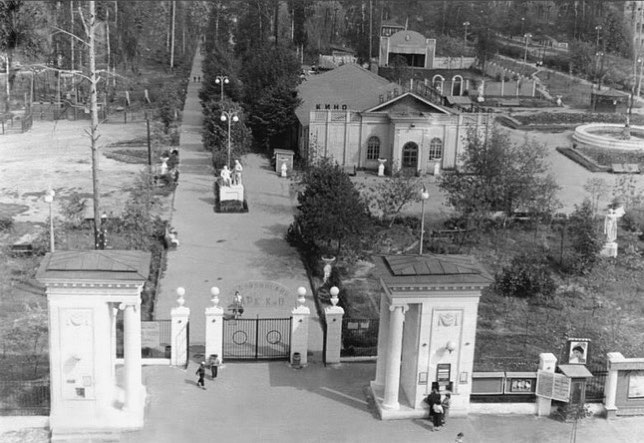Vasiliy Grossman’s front-line reportage The Army of Stalingrad from the 13th of January 1943 mentioned the Sculpture Garden and its defence. Every district of Stalingrad, its every corner turned into a battleground in those fateful months, and the park ensemble was no different. The history below is a translation of the story told on the official pages of the then Sculpture Garden ensemble, that today carries the name of Yury Gagarin. Several photos are taken from their site as well.
Prologue
The Park and the Palace of Culture of the Krasnooktyabrsky district of Volgograd, which make up a single cultural and entertainment complex and named after the legendary cosmonaut Yuri Alekseevich Gagarin, is one of the oldest cultural complexes of the city and the region.
In 1925-1930, a recreation park was set up in the Barricade district of Stalingrad, above Lenin Avenue, directly opposite factory “Barricade”.
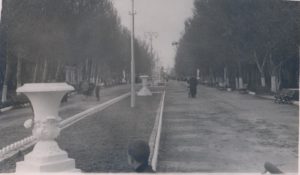
The history of the park’s names is interesting. One can find the name “Sculpture Garden” in some sources, and, indeed, in the pre-war period, the main alley of the park was decorated in a ceremonial style: with flowerbeds, flowerpots and sculptures.
Later, and especially during the war, the park was called “Airport Park”, and the lane next to it was also called that. There has never been an airport or anything else related to aviation nearby, but it is known that in 1940-1941 a parachute jumping tower was installed in the park, the highest in the city. Many young people of Stalingrad were trained here.
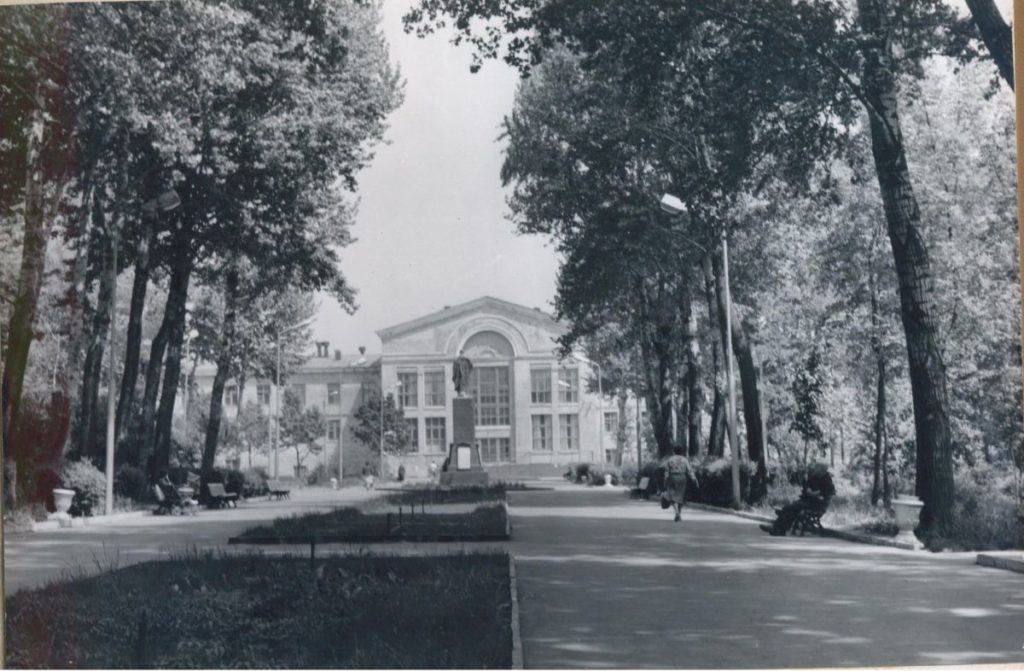
However, November 18, 1936 is considered to be the birthday of the park. It was on this day that the House of Culture was opened next to the park, which forms a single ensemble together with the park.
The War
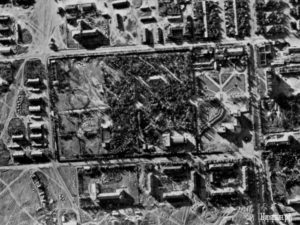
The Battle of Stalingrad came to the Airport Park in October 1942. In an effort to not let the enemy pass to the Volga, the 308th Rifle Division under the command of General Gurtyev took up defence in the park.
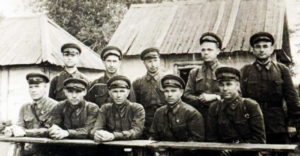
The 308th Division was formed in the spring of 1942 based on the Omsk Military Infantry School named after Frunze. At the end of August, the new division was transferred to the Volga. Initially, the 308th Division was counted about 9,000 people. After participating in the bloody battles, the division lost more than half of its personnel, by the 20th of September its number was 4,467 people. By the order of the 30th of September the division was incorporated into the 62nd Army, under the command of General Chuikov. On the 1st of October the units of the division began to be transported across the Volga, directly to Stalingrad. At that time, there were 4,055 people in it.
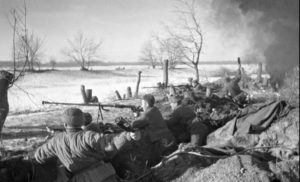
Life in the House of Culture and the Park froze because of the military actions. The Airport Park, surrounded by Stakhanovsky Avenue, Arbatskaya, Airport and Sculpture Streets, occupied an important place in the defence system of the 308th Infantry Division. Due to the large number of tanks involved in this direction by the German command, the Airport Park was initially equipped as a fortified anti-tank area designed to detain the enemy in front of the Barricade plant. Minefields were created around the park, a large number of ignition mixture bottles were stored. Several bottles were placed in such a way that shooting them would ignite the entire field. The Recreation Center building and other 12 separate buildings located in the park and the surrounding area were also used for combat: embrasures were made in them, basements were used as shelters, specially dug communication passages led to the buildings. Subsequently, the battles at the Airport Park went down in history as one of the best examples of anti-tank defence in a city.

The front came right up to this place by the beginning of October 1942. The park and the soldiers in it were subjected to a strong artillery and air strike, tanks accompanied by machine gunners were attacking. One peculiarity of our defence in this area was that at the north-western corner of the park, along the Sculpture Street (today it is Street named after Pelshe), a large number of well–disguised ignition mixture bottles were laid out – a whole “bottle field”.
“In the afternoon of October 8, up to two companies of Hitlerites with five tanks and a platoon of submachine gunners attacked the battle formations of one of the companies of the 339th regiment. The forward tank drove into the bottle field at top speed and, crushing several bottles, caught fire. The submachine gunners from this tank and the one following it began to throw earth at the tank and came under fire from our riflemen. The fire spread further and further, the bottles burst from the flames. A powerful fire barrier was created. The Fascists suffered heavy losses. To replace the torched tanks, the Germans sent a new group of tanks along a detour. According to the combat results of the day, the commander reported ten damaged tanks. On this day, the Gurtyevites repulsed six fierce attacks by the Nazis.” (From A.D. Kolesnikov’s book “The 308th Rifle Division in the Battles for Stalingrad”)
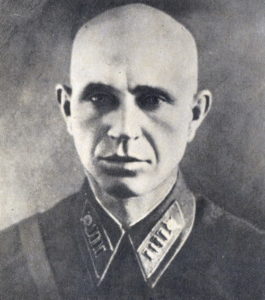
From the memoirs of Leonty Gurtjev: “We all remained completely calm and in the most difficult moments, when it seemed that there was no way out, we took our guns and were ready to act to the end. No one had any thoughts of leaving. If you were glancing at the Volga, it was only in waiting for the reinforcements and ammunition from there. Everyone was conscious of a sense of duty.”
During the fighting in the area of the Airport Park, the 308th Infantry withstood more than 100 attacks, destroyed 70 tanks, 5 aircraft, up to 10 thousand enemy soldiers and officers. The commander of the 62nd Army Vasily Chuikov highly appreciated the contribution of the 308th Infantry Division to the victory in the Battle of Stalingrad. Leonty Gurtjev was awarded the rank of Major General, and the division was awarded the Order of the Red Banner for exemplary performance of combat tasks and courage and bravery shown by the personnel. In 1979, Aeroportovskaya Street was renamed to General Gurtjev Street.

In the days of the hardest battles for the Airport Park, the dead were buried in mass and single graves, often made in the craters from the explosions of large bombs. With the liberation of the city, after February 2, 1943, began the restoration of buildings and the demining of areas where the most brutal battles took place. A mass grave was created on the central alley of the park, in which about 2,000 people were buried.
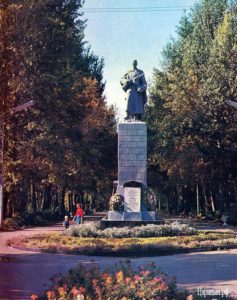
Since then and to this day, there is a mass grave on the Central Alley of the park with a monument to the fallen soldiers of the 308th Division installed on it in 1954. The grave has been recognized as an object of cultural heritage of regional significance by the Order of the Committee of Culture of the Volgograd Region No. 01-20/62 “The mass grave of soldiers of 62 and 65 armies”, dated February 1, 2016. The monument was designed by architect G.M. Kamyshev. The base for the pedestal is a low square, made of concrete, lined with dark brown granite slabs. On a high pedestal stands a warrior with an uncovered bowed head in a greatcoat and a cape behind his back. In his right hand he holds a submachine gun of the Shpagin system, which is pressed to his chest, and in his left hand is the helmet held at belt-height. The warrior bowed his head over the ashes of those who are buried here. The figure of a warrior is just over 2 meters high, the height of the pedestal is 4 meters. 4 marble slabs are installed around the perimeter of the monument: 3 of them have the names of the dead, the fourth has a memorial text: “Soldiers of the 62nd and 65th armies who fell to the death of the brave during the Great Battle of Stalingrad 1942-1943 are buried here.” The monument was initially turned to face the Culture House, now it is turned in the opposite direction.
The Post-War Period
In the post–war period, all four streets surrounding the park and the Palace of Culture changed their names: Aeroportovskaya Street became General Gurtjev Street, Stakhanovsky Avenue became Tarashchantsev Street (in honour of the soldiers of the Tarashchansky Regiment of the 45th Rifle Division, who stood to death for the Red October plant), Arbatovskaya was named after cosmonaut Herman Titov, and the Sculpture was renamed in honour of the Latvian communist Arvid Pelshe.
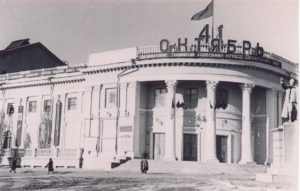
By 1959, the building of the Palace of Culture and the park were restored by the efforts of the Barricades factory. The facility became one of the first restored buildings in Stalingrad. Architectural decorations consist of pilasters with ionic capitals, a portal with a pediment, in the tympanum of which there is a round window, an inter–floor belt with dentils, a capital with acanthus leaves and Soviet symbols. The neoclassical style of the building has become the pride of the district and the city and has architectural and town-planning value today.
Creative teams returned to the Palace of Culture, residents of the city returned to the park. The factory library, evening music school and art studio continued to work in the building of the institution.
One of the favourite leisure activities for the barricades was the chess club, and in the park they danced, walked, watched movies and learned all the latest news at the “News of Life” site.
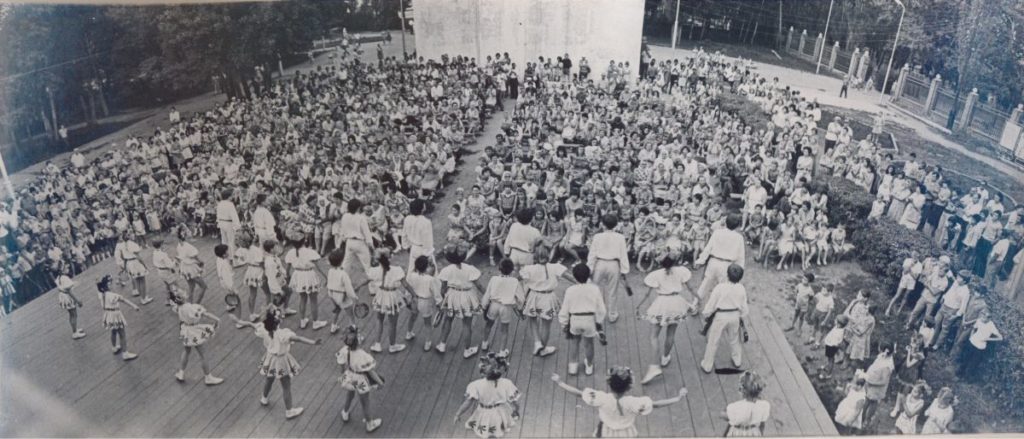
Two years after the restoration, in 1961, the “Airport Park” and the Palace of Culture were renamed in honour of Yuri Alekseevich Gagarin – the first person to fly into space. The Palace building underwent reconstruction during this period. Initially, the semicircle served as the entrance to the building, then in 1963 2 wings were completed. Inside the building there were several spacious halls and a sports complex, rehearsal rooms.

